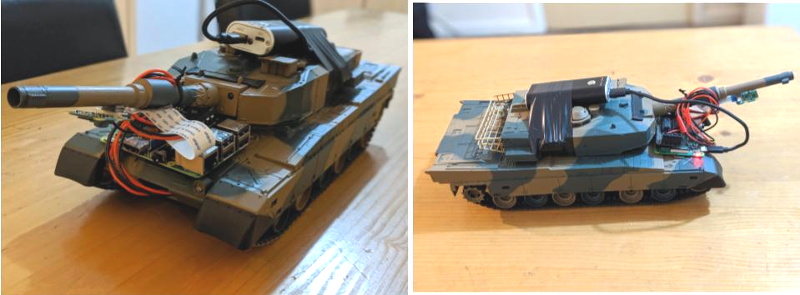If you’re looking for a simple project to start exploring the intersection of OpenCV and robotics, then the RPi Tank created by [Vishal Varghese] might be a good place to start. A Raspberry Pi and a few bits of ancillary hardware literally taped to the top of a toy M1 Abrams tank becomes a low-cost platform for testing out concepts such as network remote control and visual line following. Sure, you don’t need to base it around an Abrams tank, but if you’re going to do it you might as well do it with style.
As this is more of a tech demonstrator, the hardware details are pretty minimal. [Vishal] says you just need a relatively recent version of the Raspberry Pi, a MotoZero motor controller, and a camera module. To provide juice for the electronics you don’t need anything more exotic than a USB power bank, which in his case has been conveniently attached to the top of the turret. He doesn’t provide exact details on how the MotoZero gets wired into the Abram’s motors, but we imagine it’s straightforward enough that the average Hackaday reader probably doesn’t need it spelled out for them.
Ultimately, the software is the heart of this project, and that’s where [Vishal] really delivers. He’s provided sample Python scripts ordered by their level of complexity, from establishing a network connection on the Raspberry Pi to following a line of tape on the ground. Whether used together or examined individually, these scripts provide a great framework to get your first project rolling. Literally.
Line following robots, in their many forms, have been a favorite hacker project for years. Whether they home in with an analog circuit or replace the lines with hidden wires, they’re a great way to get started with semi-autonomous robotics.
















That’s a japanese Type 90 tank.
^^^ This guy World Of Tanks
I never made it past Tier VI, so…
Nope, but I had the same toy tank in 2004.
I’m a software guy, less a hardware guy. I’ve been wanting to make a pi-powered vehicle of my own for some time, but my soldering skills are somewhere between “bad” and “fire hazard.” Most of the “build your own robot” stuff that I’ve found requires complete kits. Any thoughts/guides on where I might have “but we imagine it’s straightforward enough that the average Hackaday reader probably doesn’t need it spelled out for them” spelled out for me? Basically: How do I identify a toy that would be good for this kind of hacking? What do I need to do to ensure I don’t damage it in the process of adding my own electronics?
I think all the things you mentioned are the essence of hacking. You will damage things in the process of it. Don’t be afraid of it.
If you are afraid of it, sure there are plenty of kits and guide out there which take you by the hand, but maybe just try it on your own! Try to find the exact thing you want and start hacking.
Realistically, with a simple toy like this you’re going to be looking at brushed motors that only have two wires coming out of them. Worst case scenario, you get the polarity of the wires wrong and the tank goes backwards when you want it to go forward. Flip the wires and you’re good to go.
The MotoZero offers some very nice documentation that walks you through this process, though of course there are other options out there for motor controllers and you don’t have to use the one [Vishal] did.
Part of the learning process. Plus, any fire would be smaller than you think. Probably at most you could pop a motor driver, they are super cheap.